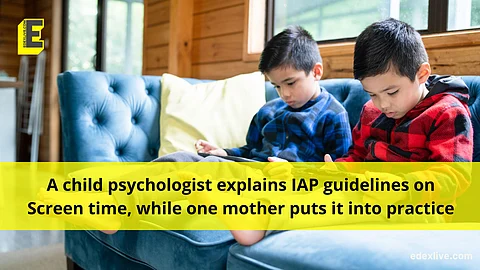

We live an age shaped, if not defined, by the omnipresence of digital devices. Screens flicker at us from every corner of life, quietly reshaping how we think, interact, and even raise our children. For the generation born into this environment, the swipe of a finger comes as naturally as a heartbeat.
Children today navigate smartphones and tablets with a fluency that often surpasses that of their parents, not because they are taught, but because these devices are as familiar to them as toys once were to us.
In the quiet tug-of-war between nurturing and seeking respite, it is tempting, and alarmingly easy, to hand a device to a child. Yet in the comfort of that convenience lies a profound dilemma. At what point does the glow of the screen stop soothing and start becoming dangerous? When does passive engagement slip into dependence, and distraction evolve into addiction?
The line is thin and perilous, often blurred by good intentions.
Divya Kevin, a software entrepreneur and new mother, has asked herself this very question. Her daughter is not yet two, but Divya’s choices around digital exposure is already deliberate.
“We don’t expose her to screens at all,” she says. “If we want to watch something, we wait until she’s asleep.”
This intentional approach reflects a growing awareness among parents navigating the digital age. The Indian Academy of Pediatrics (IAP) recommends zero screen time for children under two, recognising that direct human interaction far outweighs any digital content during these crucial developmental months.
Dr Sonika Divit, a child psychologist from Bengaluru, has witnessed the profound impact of this shift firsthand. Her research on “The Impact of Excessive Screen Time on the Cognitive and Social Development of Preschool-Aged Children in Urban Indian Family Settings” reveals a stark reality: excessive screen exposure is linked to reduced attention spans, delayed language acquisition, and weakened social skills.
"By age six, 99% of the brain is developed," she explains. "During this critical window, constant digital stimulation can disrupt neural connections, leading to developmental delays."
What began as a convenience during COVID lockdowns has evolved into a generational habit. Parents, often juggling work demands, find screens an easy solution for engaging restless children. Yet this convenience carries hidden costs.
The IAP's comprehensive guidelines emphasise that when screen time begins to displace essential daily activities such as sleep, physical play, face-to-face interaction, and learning, it becomes "excessive and harmful."
Children aged three to five are in their preoperational stage, developing imagination and thinking capacity. Screens can rob them of these vital learning moments.
Dr Divit's research showed higher BMI levels and reduced physical activity among high screen time children, alongside concerning patterns of emotional dysregulation and decreased empathy.
"Children mirror parental behaviour," Dr Divit observes. "When parents are constantly on their phones, it normalises screen attachment." This unconscious modeling sends a powerful message that screens are central to daily life.
She emphasises that for parents working from home, setting up a dedicated workspace that’s off-limits to the child can make a big difference. This physical separation not only establishes clear boundaries but also helps reduce the chances of children imitating constant screen use.
When children struggle with screen addiction, Dr Divit advises parents to firmly limit exposure by keeping devices out of sight and encouraging friends and family to message instead of calling, allowing responses when the child isn’t present. She emphasises redirecting children’s attention to engaging activities like outdoor play, reading, or playdates.
Importantly, parents must also reflect on their own screen habits, as children learn more from what they observe than what they’re told. Breaking the constant reliance on screens is essential.
For Divya, motherhood has catalysed profound changes in her own digital habits. "I've consciously stepped away from social media platforms like Instagram and YouTube," she shares. "The only digital content I engage with now is Spotify, weekly Netflix sessions, and Masterclass. Motherhood has helped me make lifestyle changes I've been meaning to do for years."
This self-awareness extends to her future parenting plans. When her daughter turns two, Divya envisions limited, purposeful screen time that support language and speech development. "I want her to engage with one activity at a time," she emphasises. "If she's watching something, it should be with full attention and purpose."
Divya also looks ahead to educating her child about the digital world. “There are tools like YouTube Kids and parental controls that can help filter content and set boundaries early on. As she grows older and becomes more curious, I’d want to gradually introduce her to concepts like digital privacy, consent, and online behaviour. The goal is to build awareness step by step, while giving her enough freedom to explore safely.”
The path forward isn't about rejecting technology entirely but embracing mindful consumption. Dr Divit recommends that when screens are introduced, parents should co-view content, choosing realistic contents over overstimulating animations. "Shared viewing encourages dialogue, curiosity, and learning," she notes.
As we navigate this digital landscape, the message is clear: children don't need screens to thrive in their earliest years. They need presence, attention, and meaningful interaction.
In a world growing ever more connected, raising digitally healthy children begins with the simple act of being fully present, screen-free, in the moments that matter most.
